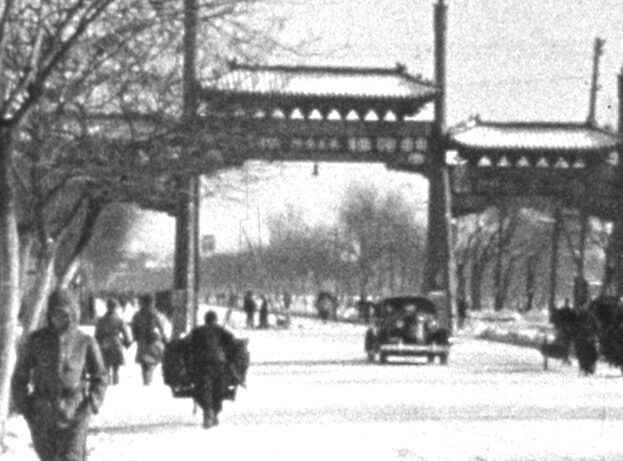"Ataman Semenov and the Kolchak Millions"
Following the revolution of 1912 which ended the two-thousand-year-old monarchy, China entered into a period of political instability lasting the best part of four decades. In theory the state was united under the successor government to the Qing dynasty, the Republic of China. In practice no one government succeeded in establishing itself over the whole country until the final military victory of the Communist Party in 1949. For much of the 1910s and into the 1920s China was split into fiefdoms controlled by ever-shifting alliances of military warlords, and the authorities of the Republic, who enjoyed international recognition as the government of all China, were merely that group which had control of Beijing and its hinterland. Scattered amongst these fiefdoms were the foreign concessions extracted from the weak Qing regime in the nineteenth century and under the control of Britain, France, Japan, the USA and other powerful states of the time.
The material in Foreign Office Files for China, 1919-1929 reflects in its diversity the tumult of this era and the extent to which China’s troubles were influenced by neighbouring states and the great powers, and to which they in turn leaked out of China to exert influence abroad. British diplomats in situ concerned themselves constantly with the successes and eclipses of the various warlords and with foreign influence on Chinese affairs, whether concrete, or rumoured, or merely projected. A chronic worry was the hold of communist ideas in China and the fear that the communist revolution that had recently become entrenched in Russia would spread: the Chinese Communist Party, founded in 1921, was known to be aided by Soviet advisers.
Another consequence of the Russian Revolution was the presence in China, particularly in the north, of Russian refugees, often connected with the counter-revolutionary ‘White’ armies which had fought the Bolsheviks in the years after 1917. Such is the provenance of Ataman Grigory Semenov (or Semenoff), who appears in the records of British diplomats in China early in 1927 in a way which exemplifies the entanglements of China at this time, both internally and with its neighbours.
Semenov was a curious figure. A former Tsarist officer and a fluent speaker of several Mongol languages (and, according to a British report, a professed descendant of the Mongol khans), he came to prominence in the confusion of post-revolutionary Russia when he established himself in Chita, in southern Siberia, at the head of a Cossack army of which he declared himself ataman, a traditional title of leadership. Around this time he seems to have nurtured the patronage of the Japanese, which he was long to enjoy in the face of British mystification as to what exactly they wanted out of him. Admiral Alexander Kolchak, the titular head of the White government, reluctantly recognised Semenov as commander of an area stretching east to the borders of Manchuria.
By the time he appears in the Foreign Office Files for China the struggle for control of Russia was long over, at least in practice, and Semenov was living, like many White exiles, in Manchuria, then under the control of the warlord Zhang Zuolin (Chang Tso-lin). In January 1927 Semenov approached the British for help in his efforts to aid an anti-communist movement in Mongolia – ruled by a Soviet-backed regime but traditionally paying homage to China – and to build military support for the northern warlord Sun Chuanfang, who was fighting the advancing forces of the Nationalist Party. Though brushed aside, some months he reappeared trying to secure for his adventures what became referred to as the ‘Kolchak millions’, funds said to have been deposited in gold with the British-controlled Hongkong and Shanghai Bank by the collapsing government of Kolchak, who had been captured and killed by the Bolsheviks in 1920. Semenov based his claim on his being the legitimate head of the White movement, a succession that he traced from Kolchak, and his latest planned scheme involved fomenting a revolt amongst Red Army units in Siberia. Although, according to British sources, already ‘well supplied with money possibly from Japanese secret funds’, Semenov claimed that he needed British approval of his plan in order to persuade Zhang Zuolin to declare him White leader in China and thus secure the gold. Zhang was also appealed to in this vein, it seems, by a group of Mongolian princes anxious to disrupt the communist domination of their homeland, but he stalemated Semenov by refusing to countenance any declaration until the money was already in the Russian’s hands.
These approaches to British diplomats, both in Manchuria and during various visits to Japan, were constantly rebuffed. Semenov was regarded by the local British as an ‘ignorant savage’ whose standing amongst the Japanese was inexplicable, one official writing in March 1928 that it would be ‘madness’ for the War Office to entertain dealings with him. However, his persistence prompted a circular from the Foreign Office instructing diplomats in China to keep all Russian émigrés at arm’s length, as ‘such persons are generally ready to […] interpret and proclaim as encouragement the mere fact that they have been given a hearing’. The British also found themselves intrigued to know whether the Kolchak millions did exist. In 1928 an investigation in Shanghai drew a blank: although HSBC did not deny that funds had been deposited, the main evidence for their existence seemed to be the strenuous efforts which several parties continued to make to secure them. A character called General Horvath, for example, was also active in northern China and representing a Russian organisation whose only aim was, according to sceptical diplomats, to get hold of the mysterious booty.
In time Semenov departed for Japan, still stymied by Zhang’s refusal to cooperate with his plans without evidence of the money: a refusal rooted, according to the British, in the latter’s interest in hard cash over restoring Chinese dominion over Mongolia. Zhang also was soon out of the picture, assassinated by a Japanese bomb in June 1928, and the warlord era itself was anyway drawing to a close, as the Nationalists’ Northern Expedition captured Beijing and secured an unsteady hold on a China in which communism was a growing and destabilising force. Yet the manoeuvrings around the Kolchak millions, real or not, serve as a small illustration of the complexity of the state in which China found itself and the opportunities which outside forces, from Russian adventurers to expanding empires like Japan, were able to find there for so long.
Foreign Office Files for China, 1919-1929 will be released next month.
Recent posts

AM’s new resource, A Global History of Epidemics, 1800-1970, offers interdisciplinary researchers unique primary sources, interactive tools from maps to timelines, and expert essays, to explore disease history, colonialism, and public health advancements within the British Empire and beyond.

AM's latest publication provides a vivid visual exploration of twentieth-century China, showcasing historical and cultural transformations. Enriched with powerful accessibility and discovery tools, and contextual resources, China on Film provides an invaluable resource for studying modern Chinese history and early film-making.
